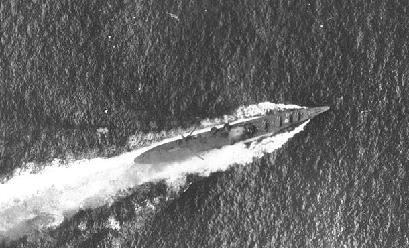![]() The Pacific War Online Encyclopedia
The Pacific War Online Encyclopedia
|
| Previous: Tomozuru Class, Japanese Torpedo Boats | Table of Contents | Next: Tonga |

Naval Historical Center #NH 82404. Cropped
by author.
| Tonnage | 11,215 tons standard displacement |
| Dimensions | 661'1" by 60'8" by 21'2" 201.50m by 18.49m by 6.45m |
| Maximum speed | 35 knots |
| Complement | 850 |
| Aircraft | 2
Kure Type 2 Model 5 catapults 5 seaplanes |
| Armament | 4x2 8"/50
guns 4x2 4.7"/45 dual-purpose guns 6x2 25mm AA guns 4x3 Long Lance torpedo tubes |
| Protection | 2073 tons 4" to 0.7" (100mm to 18mm) NVNC and Dücol machinery belt sloped 20 degrees 5.7" to 2.2" (145mm to 55mm) NVNC magazine belt 6.9" to 2.6" (175mm to 67mm) NVNC bulkheads 2.6" to 1.2" (65mm to 31mm) CNC middle deck 2.2" (56mm) lower deck over magazines 3.9"/1.4"/1.2" (100mm/35mm/30mm) steering sides/ends/crown 4.1" (105mm) max uptakes 1" (25mm) NVNC barbette 1" (25mm) NVNC turret 5.1" to 2.6" (130 mm to 70mm) side/1.6" (40mm) overhead conning tower Lower belt as torpedo holding bulkhead. Torpedo system depth 10'10" (3.3m). |
| Machinery |
4-shaft geared turbine (152,000
shp) 8 Kampon boilers |
| Bunkerage | 2163 tons fuel oil |
| Range | 9000 nautical miles (17,000 km) at 18 knots |
| Modifications |
1943: Light antiaircraft increased to 8x2
25mm guns and Type 21 radar installed. 1944-6: Light antiaircraft increased to
8x3, 6x2, 25x1 25mm guns and Type 13 and two Type 22 radar sets installed. |
The Tones were completed in 1938-39 in the Mitsubishi
Nagasaki
yards. Authorized in 1932, they were to be 8,450-ton cruisers
resembling the Mogamis, but
dissatisfaction with that design led to a new and quite different kind
of ship. The design was also influenced by the Tomozuru
Incident, which led to careful consideration of seaworthiness.
The Tones crowded all their main guns onto the forward part of the ship, a measure intended to reduce dispersion of shot. It also freed the rear of the ships for extensive plane handling facilities and resulted in ships that were unusually habitable. They had excellent range and speed and spent most of the early part of the war escorting, and scouting for, the main carrier forces. On the other hand, the unusual turret arrangement yielded an ugly profile and poor firing arcs.
The ships were originally to be partially welded.
However, because of concerns about hull strength, Chikuma was almost entirely
riveted. The design was originally announced as using 6.1" (155mm)
guns, but following the repudiation of the naval disarmament
treaties at the end of 1936, the ships were completed with 8"
(203mm) guns quickly enough to raise suspicions that the ships had been
designed for such guns from the start.
Though designed to carry up to eight seaplanes, it
appears that the ships never carried more than five, and this was
reduced to four later in the war.
| Sunk by aircraft 1945-7-24 at
Hashirajima |
||
| Sunk by aircraft 1944-10-25
off Samar |
References
CombinedFleet.com (accessed 2007-7-7)
Gogin (2010; accessed 2013-2-14)
The Pacific War Online Encyclopedia © 2007, 2009, 2011, 2013 by Kent G. Budge. Index